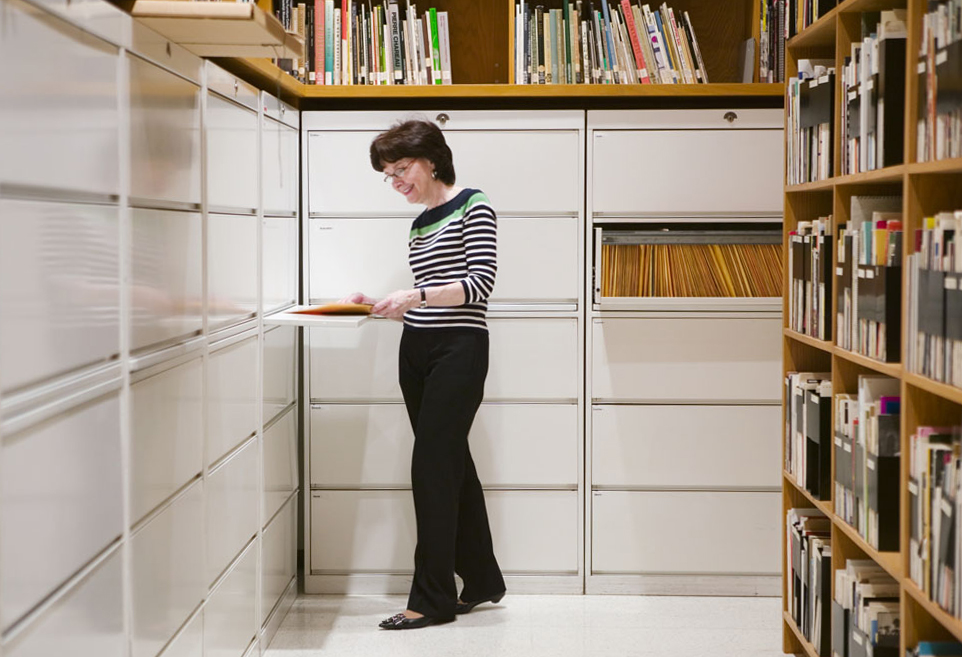 |
| Former Walker Art Center Librarian (my one-time boss, now, sadly, deceased) Rosemary Furtak working on the artist files in the museum's renovated and expanded library. |
Seems like another lifetime, twenty years ago, when I was a
library assistant at the Walker Art Center. One of the great things about that
job, aside from the remarkable history of modern art that sat on the library’s
shelves and in its drawers, was that from time to time I would be asked to meet
with visiting photographers. Because I’d been pretty involved in the medium,
could talk and listen well to photographers, even then as the 1990s were
hitting their mid-decade stride, and I liked to entertain myself thinking there
might be a future for me at the Walker if only they’d allow a curator to
concentrate on one medium as I had on photography.
Well, that was not to be. I got distracted by
medium-specific projects, including editing a quarterly journal for pARTs
Photographic Arts and curating a couple of exhibitions there, above the body
shop on Lyndale and 28th, before the organization relocated to Lake Street, the
decade ended, and pARTs became the Minnesota Center for Photography. And we all
know what happened in 2008. Well, a few of us do.
One meeting I recall vividly was a discussion with Madison,
WI-based Lewis Koch (b. 1949), who brought his portfolio in one day. We met in
the Print Study room (hey, what was that about no medium-specificity at the Walker?)
and spent a good hour looking at his Totems, vertical stacks of finely printed
black-and-whites that combine social, cultural, natural, and linguistic tropes
in what might be called piled psycho-typologies. Lewis struck me as a very
thoughtful artist, very smart in a post-modernist way, but also a very fine
photographic craftsman; his chops were all in place and appealing to the
emerging esthete in me.
 |
| Accordion-folded totem by Lewis Koch, published by Nexus Press, Atlanta, 1993 |
Somewhere I have a copy of his
publication Double Caution Totem (Nexus Press, 1993). Or maybe it stayed in the Walker Library,
which would have been better. Foldouts of three of his treatments of streetlights
and other vertical markers of the automotive landscape. Clearly, this is work
meant to be experienced ensemble, single prints merged into a whole greater
than its parts.
There’s an organic, almost effortless turn to make here into
books, more conventional volumes that nonetheless reflect a collective. sequenced interest
in images. Lewis recently sent me a couple of his independently published books,
to update my awareness of his work and to forward along to Larissa Leclair and
the Indie Photobook Library. There is Touchless Automatic Wonder: Found Text
from the Real World (Borderland Books, 2009) and Bomber: A Chance Unwinding
(Areness Press/Blurb, 2011).
 |
| Soda advertisement, Udaipur, Rajasthan, India, 1996. From Touchless Automatic Wonder by Lewis Koch |
Touchless recalls both the glories of duotone vision
(reproduction almost as good as good silver prints) and the intrigue of reading
text as both strings of letters and photographic grain amassed into light and
shadow. Koch shares a page with text recorder Nathan Lyons (almost 20 years
Koch’s senior), though Koch’s work sings more clearly to me, bittersweet and
rich like Franz Schubert’s musical Lieder. These are funny works, more strange-funny
though than ha-ha-funny. They are straight-faced yet they elicit something
uncanny, poignant, and acutely responsive to both contextual and optical
vernacular.
 |
| From Bomber: A Chance Unwinding by Lewis Koch |
Bomber, coming later and setting itself apart from Touchless
and the Totems, is an intriguing evolution of Koch’s work. The book sets
itself one subject in one place; the photographs Koch made are color, largely
lacking text, and all from a rubble field atop Bomber Mountain in the Cloud
Peak Wilderness, Big Horn National Forest, Wyoming. The mountain was named for
a B-17 that crashed here in 1943; evidence of the crash, the tangled remains of
the plane, are strewn across a site that is eminently undistinguished aside
from the wreckage. Each fragment speaks of the betrayal of myth—whatever magic
(Bernoulli effect, bah!) keeps planes in the air failed here, and the penalty
was harsh.
Koch’s photographs in the modest volume are sequenced with archival
Air Force images, bombing maps, and Koch’s own concrete poetry, which weaves a
thread that figuratively draws the pieces back together again. It is an elegiac
and enlightened bit of work that shows a great deal of daring and personal
commitment; making the photographs alone, which he did on two trips, was an
ordeal in a very inhospitable place where there were, Koch writes:
Gleaming shardson a field of stones—rubble on rubbleand clouds, cloudsin every directionincluding down,
There is something reflective in the Bomber project, signaled
perhaps by its subtitle, A Chance Unwinding, which is an elusive yet
provocative phrase. I feel the photographer unwinding, looking back, casting
this arbitrary and indifferent landscape as a metaphoric field where he has
operated for years, spotting and capturing moments of twisted brilliance lodged
in between the mundane earthen boulders and the ethereal yet expansive clouds.
A nice symbolic self-portrait of the artist as visual poet/alchemist, turning dross and
jetsam into significant texts.



i presume that piece of plane in the photo was strategically placed where it is. fabulous photo.
ReplyDelete